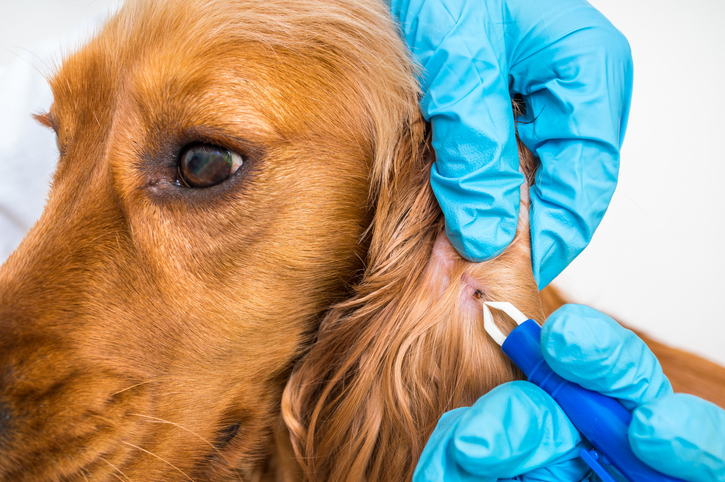Have you ever heard of ringworm before? Did you know that it is contagious to both dogs and cats? Although ringworm isn’t usually a painful or itchy condition, it can become a big problem if it’s left alone. Ringworm can also be pretty unsightly on your dog! If left untreated, it can spread over large parts of the body and cause other skin, hair, and nail problems.
We discuss below what ringworm really is, how to identify its symptoms, and what to do about it.
Ringworm Isn’t Really a Worm—it’s a Fungus
Ringworm is not in the same category as a hookworm, roundworm, or tapeworm. In fact, it is not a worm at all. This fungus, which affects the skin and leaves circular or semi-circular bald spots and rashes, is a fungal infection that gets its name from the ring-like, worm-like shape visible on raised and red skin rashes.
Ringworm is the common name for these fungal infections that affect the skin; its scientific name is “dermatophytosis”. The three common species causing skin problems in dogs and cats are Microsporum canis, Microsporum gypseum, and Trichophyton metagrophytes. The disease can affect dogs, cats, and even humans. On humans, it causes a red circular or patchy rash to develop, and when it gets on the feet it is known as “athlete’s foot.”
If your dog catches ringworm, please remember that this fungal infection can also infect people. You have to be careful to not catch it until your pup has received successful treatment and the problem has been resolved.
Symptoms of Ringworm
Bring your pooch to a dog hospital if you notice any of these symptoms of a ringworm infection. Even if you don’t see the characteristic circular rash, which may not be noticeable, these are reasons for a visit to your family vet:
- Dry, brittle hair with hair follicles that break easily
- Inflamed, red skin rash
- Circular or patchy areas of hair loss (alopecia)
- Scales that look like dandruff
- Scabs or raised nodular lesions on the skin
- Darkened skin (hyperpigmentation)
- Reddened skin (erythema)
- Inflamed folds of the skin around the claws, or bordering the nails
- Itchiness (pruritus)
How Ringworm Gets Around
Ringworm is spread either through direct contact with an infected animal or from an object that has been contaminated such as towels, bedding, a comb or brush, food or water bowls, a couch, or carpets. The fungus spores can survive for many months, which means ringworm can be spread via hair that has been shed. It can also remain on surfaces or trapped in the fibres of carpets, drapes, and linens in your home if they’re not cleaned.
Dogs may often get the fungal infection from playing at the playground as some forms of the fungus can freely live in soil. Once the fungus ends up on the skin, even the slightest trauma to that part of the skin can expose the body to a ringworm infection. After this, the pet’s immune system may fight the fungus off, or it may turn in to a localized or more widespread skin infection, depending on many factors including the pet’s overall health, the species of fungus, part of the body affected, the pet’s age, and so on.
Sometimes a pet can be a ringworm carrier but they don’t have any visible symptoms. If your dog has been diagnosed with ringworm, it is a good idea to have your other pets checked by a veterinarian. You should also alert your fellow dog owners and dog-walking buddies that your dog has been infected and is being treated, and that they should watch for signs of ringworm in their own pets.
If your dog has been visiting other dogs or has been in a kennel or animal shelter, he or she should be watched carefully for problems like ringworm, fleas, ticks, and any other parasites that travel via infected skin or hair with which your pup has been in contact with.
Good Treatments are Available
There are other more common conditions besides ringworm that can cause hair loss and rashes, so if you do notice symptoms of ringworm in your dog, take them to your family veterinarian. Do not self-diagnose this condition as it is never based on visual clues alone and diagnostic testing is always needed, not just to diagnose ringworm, but also to help find out the species of ringworm and decide what may be the best available treatment for that species. Bacterial skin infection (pyoderma), skin yeast infections, and allergies are some other more common problems that affect dogs and may look similar to ringworm to the untrained eye.
If your pet is diagnosed with ringworm, there are a variety of good treatments available. Your vet will help you choose the solution best suited for your dog depending on the severity of their ringworm problem.
These are the usual methods to treat ringworm:
- Topical medication
- Anti-fungal oral medication
- Environmental decontamination
Your vet may also suggest that your dog’s hair be trimmed off in the more infected areas. Do not assume your dog is free of the infection once their symptoms are no longer visible. Continue to treat your pet until your veterinarian pronounces them cured.
Although it does not commonly affect dogs, ringworm is a troublesome problem that is best dealt with soon after you notice its symptoms. Remember the symptoms we discussed above and do pursue a vet consultation if any of the symptoms are noted, as it may be due to ringworm or another skin problem that needs to be dealt with promptly so your pooch can stay healthy and comfortable.
Creative Commons Attribution: Permission is granted to repost this article in its entirety with credit to Hastings Veterinary Hospital and a clickable link back to this page.






